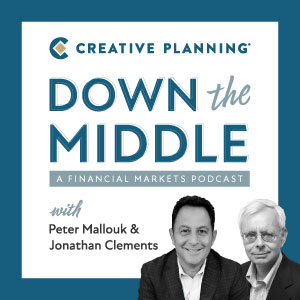Gifting and charitable giving are great ways to make an impact. But how should you determine which people and causes to support? This month, Peter and Jonathan discuss how to become intentional about your giving. Plus, learn the benefits of establishing a donor-advised fund and why you might consider funding a Roth IRA for your teen.
Hosted by Creative Planning’s Director of Financial Education, Jonathan Clements, and President, Peter Mallouk, this podcast takes a closer look into topics that affect investors. Included are in-depth discussions on financial planning issues, the economy and the markets. Plus, you won’t want to miss each of their monthly tips!
Important Legal Disclosure:
creativeplanning.com/important-disclosure-information/
Have questions or topic suggestions?
Email us @ podcasts@creativeplanning.com
Transcript:
Jonathan Clements: This is Jonathan Clements, Director of Financial Education for Creative Planning. With me is Peter Mallouk, President of the firm. And we are Down the Middle. Two months ago, Peter and I discussed how to raise money-savvy kids. This month we’re returning to the family theme, talking about the topic of giving, both within the family and outside causes. Peter, if families want to take a thoughtful approach to giving, where do they start? I imagine the first step is to think about what it is that you value.
Peter Mallouk: One of the mistakes I see people make is one that I made myself: you start out, you get going in life, you’re giving here and there. And some of the giving is obvious. You’re in a church, you give to the church. And you’re in a school, you give to the school. And your friends are in charities and you give to those charities. But then what happens is as life goes on, if you’re not intentional about giving, things just come at you and you wind up saying yes to some things and not to others. And you really wake up one day and go, “Hey, I don’t really control what I’m doing here. I don’t control where my dollars are going. I don’t control where my time is going. Does this even really align with my values or am I just sorting what’s inbound?”
So the first very big step is be intentional and develop a mission statement. Now, this doesn’t mean every family needs to sit down and write down, here’s exactly what we care about and we’re all about. But at least in your head, if you’re single, at least have a plan. If you’re married, sit down with your spouse, go, “What are the things we care about the most?” Veronica and I, we’re very focused on alleviating suffering. So breaking the cycle of poverty, food insecurity, things like that. You start to narrow things down. So you might have two or three things like that and all of a sudden 90% of the stuff coming at you realize doesn’t fit that at all. You’ve been giving to things that don’t match your values. And so that to me is always the starting point. It’s not that different from financial planning. Where am I starting? Where am I trying to go? What am I trying to accomplish? And is everything I’m doing heading towards what I’m trying to accomplish? If not, stop doing it. Do more of what is in line with your values.
Jonathan: So Peter, in your mind, is there an optimal number of charities that a family might support? I mean, is it three? Is it six? Is it 10? When is it too many?
Peter: So I think this is very philosophical. So you have a lot of people that give to charity because it’s like doing business. For example, every business in America, 99% of them are really just about doing business. So they might hit a whole bunch of things in a whole bunch of ways. But an individual, a family, if you’ve got a clear mission, probably part of that is you want to make an impact. And so a lot of people really look for things where they know that they’re going to get the most bang for their buck.
So for people that they’re giving generously but it’s not a lot of dollars, as long as you’re focused on charities that are really carrying out your mission and that are efficient with your dollars, they have good outcomes. It doesn’t really matter if you do a bunch or a few. Those dollars are in line with your values and they’re heading in the right direction. If you’ve been super fortunate, you’ve got a lot to give, say a million or more over time, those folks tend to be much more selective: “Hey, I’m really going to narrow it down to a few things. And where can I really move the needle in a big way here?” It’s counterintuitive, I think, to how most people would think about the way people generally give.
Jonathan: So if you have particular things, you mentioned alleviating suffering, how important is it to get your family on board with that particular theme? And do you think it’s powerful for families when they’re all focused on one particular goal with their giving?
Peter: So, first, when we say one thing, just sticking with this alleviating suffering theme, that is a lot of things. That can be scholarships for people that had very unfortunate lives up to a certain point but show academic prowess. It can be supplying people with things they need for basic needs. It can be a lot of different things. So when people say, “I’m focused on the arts.” Or, “I’m focused on education.” Or, “I’m focused on healthcare.” This really is a wide set of options. I coach clients to actually narrow the language, because when they’re gone, I’ve seen clients that they leave money in a donor-advised fund and their kids run it and they say, “Oh, I want to benefit this kind of thing,” and their kids can really take that interpretation and go anywhere with it. I can feel the parents rolling over in their graves. And so it helps over time to actually get as specific as you can around those things.
Jonathan: So when I was a lowly newspaper reporter, Peter, and my kids were younger and I didn’t have a whole lot of money, I thought about how I wanted to use the dollars that I had. And in terms of my kids, I wanted to pay for them to go to college. I wanted to have money for them when they got out of college to make a house down payment. I wanted to get them started on retirement savings. Meanwhile, there were some things I really didn’t care about. I didn’t want to pay for the big lavish wedding. I didn’t want to buy them some brand new car when they got out of college or when they went off to college. I mean, those were my values and I targeted the dollars I gave my kids towards those goals. Do you think that was okay? Or do you think that’s over controlling?
Peter: I think it’s okay. I think that there are some things that when you’re doing charitable giving or you’re doing giving within the family, I think having that aligned with your values makes a lot of sense because you’re setting an example. It’s part of education. I do think there are different types of gifts that it doesn’t make sense to control. It’s one thing if you’re saying, “Hey, I’m paying for your college. I’m paying for your room and board. I’m going to buy these kinds of things.” But I think when the kids are older, when they’re not kids anymore, we use the word “kids”… our kids aren’t really kids anymore. When they’re adults, I think at that point, the giving needs to be giving.
And I see sometimes clients talk about, I’ll never forget, some of my favorite clients were in my office and they said, “We gave our kids a couple thousand dollars and we really hoped that they were going to pay off this debt. And we went to their house and they’d bought a new couch. We were just so upset. And every time we go in the house, we think about that.” And they talked about an awakening that they had: when you give, it’s not really a true gift if you’re controlling it completely, right? And you have to give and let go. “This is a gift from me to you and you’re going to do with it what you will.” And I think if you’re giving to adults, that’s the only way I think it needs to be.
Jonathan: So that’s an interesting notion. So your kids are in their 20s or perhaps their 30s and you start giving them money without any strings attached. You’re not saying use it for this purpose or that purpose. In many ways, isn’t that sort of an interesting exercise as a chance to give your kids, as it were, a test run with their future inheritance to see how they’re going to use it and you as the parent can observe whether they use the money prudently or not and that might guide how you handle your estate, wouldn’t you say?
Peter: I think it’s a great real-life observation in that it doesn’t take a lot to learn really fast how those gifts are gonna be used and the mentality that people have. I mean, I think all of these things around giving within a family and giving to a charity, first you do it through example. They’re observing what you’re doing, which of course matters more than anything that you say. They’re watching what you’re doing, where you’re spending your time, where you’re spending your money. And then eventually you’re bringing them in to do those things with you and you’re being controlling. And then eventually you just give it to them. And when you give it to them, we see what stuck and what didn’t stick. Did we really succeed at this or not? And I do think it’s a great way to then see, do I have real problems here which you can control with estate planning and so on? Or do you have a tremendous amount of confidence? Or is it somewhere in between?
Jonathan: All right, Peter, so it’s that time of the month. What tip of the month do you have for us?
Peter: I’m actually going to change it based on this dialogue. A lot of people have donor-advised funds. Donor-advised funds are a foundation a family can set up on their own. And so a lot of people when they think of a charity, they think of the Red Cross or something like that, a museum. Those are set up as 501(c)(3)s. And if you were to set up your own 501(c)(3), you’d have legal work every year, tax work every year. You could have a payroll, fund raise, do all kinds of things. But it’s a lot of work. Instead, you can do something really simple called a donor-advised fund. All your information stays private, you get a bigger tax break, there’s no excise tax on the investments, there’s no money forced out every year. You can develop a family mission statement and you can gift to that donor-advised fund and get a tax deduction today.
Even if today you don’t have the time to think about the things, Jonathan, you and I are talking about, like what are my values? What is my mission? How do I transfer knowledge to another generation about giving? You can set up that foundation today and move money into it and you can sell any of the securities you donated without paying capital gains taxes. Anything that you donate there, you’ll get an income tax deduction. And you can decide next year or the year after to distribute the money to charities. And what I like about donor-advised funds is, light on legal requirements and tax requirements, big tax breaks, but also you can create a vehicle for giving where you can teach. So you can set up a donor-advised fund and you can move money into it. And then from there, your kids can learn giving. And our family, my wife lost both their parents over a very short period of time over the last 15 months and they had left a donor-advised fund to their kids and a part of that went to our kids.
And so I’m excited about them having this small donor-advised fund. It has guidelines. There’s a community that they’re from that has to benefit and they’re Catholic and so on. And it has some requirements. But the kids have a lot of discretion within those requirements of how to give. And I think it’s going to be a great learning experience for them. And what a great way for them to feel the legacy of their grandparents, which they witnessed every day, all the time. They knew exactly what they were about and they can still carry that out on their own. I think it’s an incredible legacy and a fantastic gift. I encourage everybody that is in a position to do so to consider a donor-advised fund. It can also simplify your giving. Instead of writing checks to 30 or 40 charities a year, you could have one donor-advised fund, you’ve got one tax deduction, and you make your gifts from there throughout the year. So I’m very passionate about the subject of donor-advised funds because I’ve seen it empower families to do a lot of wonderful things in a very simple fashion.
Jonathan: So Peter, on the topic of teaching your kids and giving, my tip of the month is if your teenagers or your college students have earned income this summer, consider funding a Roth IRA on their behalf. I know a lot of parents say, “Oh, the kids should be putting the money into the Roth IRA.” I don’t think it’s that important. If your kids have earned income, if they have two grand of earned income, put $2,000 into that Roth IRA for them. It’ll be a chance not only to get them started on a retirement and potentially decades of tax-free growth, but more important, it’s a chance to teach your kids about investing and about the importance of saving. Open the account, put the money in, show the account statement to your kids when it arrives in the mail, talk to them about why you picked the investments that you picked. It’s a great learning opportunity. And that will pay far greater dividends than the actual money that you would invest. So this is Jonathan Clements, Director of Financial Education for Creative Planning. I’ve been talking to Peter Mallouk, President of the firm. And we are Down the Middle.
Disclosure: This show is designed to be informational in nature and does not constitute investment advice. Different types of investments involve varying degrees of risk, and there can be no assurance that the future performance of any specific investment or investment strategy, including those discussed on this show, will be profitable or equal any historical performance levels.





